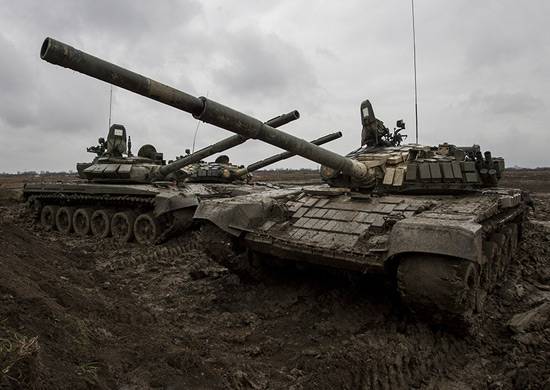Ukrainian "expert": Having met resistance in the Donbass, the Russian Armed Forces began to withdraw ...
The topic for the considerations of the Ukrainian "experts" was not only the soon-starting Russian-Belarusian military maneuvers "West-2017", but also the already completed exercises tank and motorized rifle units in the Chelyabinsk region. The maneuvers at the Chebarkul training ground, as some conspiracy theorists in Kiev note, are almost a prelude to the "invasion."

This is how the Ukrainian “expert” Yury Butusov, who is in charge of ATO propaganda, commented on the teachings of the Russian tankers the other day. To evaluate the statements of the "expert" we cite its publication in full.
For his reasons (text author's):
And look, what changes are made curious:
"A rare technique of through attacks was used by tankers during a bilateral tactical exercise at the Chebarkul training ground. The advancing tanks, with the support of motorized riflemen, wedged defenders in full battle, literally squeezing through them, practicing close combat and breaking through the defensive line. After breaking through, the attacking units turned around and turned around passed to the defense, the defenders went to the offensive, which allowed to work out several types of combat.
Two battalion tactical groups of the 90 Tank Division reinforced by units of motorized infantry, missile forces and artillery, sappers and electronic warfare - in total more than 1,5 thousand people and more 300 units of equipment took part in practical actions.
In the course of the exercise, the military received the experience of "non-standard, unexpected for the enemy forms and methods of using units, immediate response to the changing situation.
End-to-end attacks made it possible to inculcate in personnel the skills for estimating the distance to targets, the ability to advance quickly and in an organized manner, to take advantage of melee combat, and also to quickly restore the integrity of the battle formations. The methodology for training troops in attack and when repelling it was developed by the great Russian commander Alexander Suvorov in the 18th century. The trainees were divided into two sides, lined up in battle formations against each other. Units in turn attacked and defended, passing through the borders of the opposing side, "said the assistant commander of the Central Military District."
Methodology of Suvorov in contact bout it is strong. After all, the Generalissimo taught - "bullet - fool, bayonet - well done ". Well, of course, the plinth level of Russian political politicians is understandable - I hope that they all ran there in dense columns with attached bayonets. But this is humor.
Mr. Butusov’s baseboard level does not allow him to understand that comparing the name of the Suvorov’s onslaught with the Suvorov’s phrase about the bayonet could have come to mind to a complete ignoramus. After all, it is the same as to consider the name of the ship “Hetman Sagaidachny” somehow associated with the fact that the crew should have from armaments only what was at the said hetman ...
Butusov continues:
But undoubtedly - the 90-division is working out the Ukrainian scenario - in the case, for example, of conducting local operations in the occupied territory, on the model of Georgia's 2008.
There is a sense to prepare troops for contact battles and for penetration through strongholds, for attacks and counterattacks. The army must conduct maneuverable fighting. For this, troops must be prepared even for the most dangerous scenarios — including if necessary — to break through the deployed defensive orders. That is, to contact fights that bring great losses.
It is worth noting that the 90-division conducts maneuvers not by regiments but by battalion groups. This suggests that, despite the return to the divisional-regimental structure, the Russian army sees the battalion tactical as the main operational unit (Butusov’s ignorance does not allow him to understand that there are no "tactical battalion", but - note. "IN") group, not the regiment, as it would be logical to assume.
An important event is the attempt of the Russian generals to introduce the bilateral character of maneuvers, to introduce elements of improvisation and initiative into the actions of the commanders of the tactical level.
Unfortunately, bilateral exercises in the Ukrainian army are not practiced often. But they are rightly spoken by knowledgeable people like Evgeniy Wolf, and so it is accepted in NATO armies, modern combat training of units and formations should take place according to the scenario of bilateral military games, in order to work out first of all the competent work of staffs, initiative and independence of commanders in a complex and unclear situation in the conditions of mutual pressure of opponents.
It is only in such conditions that one can determine which commander is able to act competently and proactively, who has greater coherence of the headquarters and team, who has a higher level of combat readiness, who has better plans and maneuvers.
Amazing logic. Just now, Butusov ignorantly mocked the Russian Armed Forces, conducting bilateral maneuvers, and immediately said that for NATO countries such exercises are a normal and justifiable practice ... Moreover, the “expert” complains that such exercises are not held in the Armed Forces of Ukraine.
Information